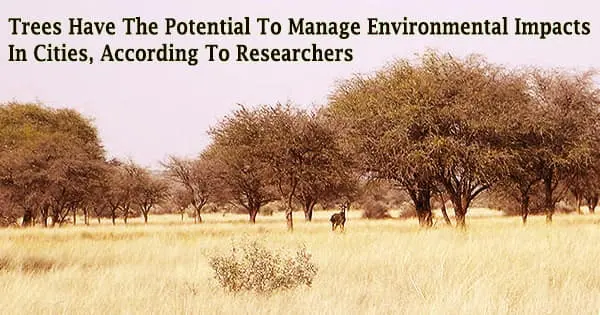Nature-based solutions are gaining new levels of interest as the global climate change discourse heats up and countries seek to reduce environmental consequences in their own backyards.
Although trees are well-known for their involvement in carbon sequestration and absorbing and storing rainwater in their canopy to manage storm-water runoff, there has been little research and clarity on how urban forests, in particular, might be employed as practical storm-water management tools.
Academics assume that urban trees can help alleviate storm-water flows, but the exact amount of rainwater that trees remove through activities such as transpiration, infiltration, and storage is unknown.
To close this gap, University of Maryland researchers conducted an empirical field investigation, finding that single urban trees, such as street trees, perform differently than trees planted in clusters with much higher transpiration rates. This finding sheds new light on how to manage the landscape in urban areas to mitigate the negative consequences of storm-water runoff.
Mitch Pavao-Zuckerman and Sarah Ponte of the University of Maryland’s Department of Environmental Science and Technology, in collaboration with the Center for Watershed Protection and the United States Forest Service, reported the findings in Scientific Reports.
“This work is important because urban trees are increasingly being considered as a storm-water management practice, but we don’t have much information about how trees function in different parts of the landscape,” explains Deb Caraco, a senior watershed engineer with the Center for Watershed Protection.
“Quantifying the effects of urban trees on various aspects of the water balance, such as the evapotranspiration component addressed in Mitch and Sarah’s study, helps us better understand the benefits of urban trees and where and how to plant and preserve them for maximum benefit.”
Pavao Zuckerman’s team evaluated three distinct urban settings single trees over turf grass and a cluster of trees over turf grass in Montgomery County, and a closed canopy forest with a leaf litter layer in Baltimore, Md., to better understand how the relationships between transpiration and environmental influences change within different tree management contexts.
This work is important because urban trees are increasingly being considered as a storm-water management practice, but we don’t have much information about how trees function in different parts of the landscape.
Deb Caraco
They implanted sap flow sensors in 18 mature red maple trees to continuously record transpiration rates during the growing season, which provide a fuller picture of how trees obtain groundwater. At each location, they also took measurements of soil water content, air temperature, relative humidity, and precipitation.
Closed canopy or cluster trees exhibited a substantially higher transpiration rate and were more responsive to climate changes than single trees. This information has far-reaching ramifications for the future.
“This work explores how trees function in different urban contexts, say street trees vs. a forest patch, where their environments are very different than non-urban trees,” explains Pavao-Zuckerman.
“Cities can be hotter and drier for example. Our data can help make tree crediting policies better reflect the actual benefits of trees in urban landscapes because they interact with water and their environment differently in cities than they do outside cities. Our next step is to take this data set on how each tree functions and scale it up to see how an entire stand or patch of trees mitigates storm-water flows.”
Some people think of trees as having the same characteristics no matter where they grow, but thanks to Pavao-research, Zuckerman’s we now know that the same tree species can help mitigate storm-water in cities, which affects flooding and water quality, which are becoming increasingly important public-facing issues.
“This work emphasizes the importance of thinking about cities as not a homogenous thing that we’re trying to manage, but that environmental outcomes and benefits are going to vary within a city,” says Pavao-Zuckerman.
“A tree along a street isn’t the same as a tree in a patch or woodlot. Considering this variability is important in our future research we are now modeling how these different settings may mitigate runoff from different sized rain storms for example.”
These findings, according to Pavao-Zuckerman, can be useful guides for those controlling urban stormwater runoff. And that the current technique of depending on data collected in non-urban areas should be abandoned.
Urban trees may now be better integrated into storm-water green infrastructure networks by practitioners. These findings suggest that data generated from urban environments, rather than non-urban sites, should be used to develop strategies for using urban trees and forests to reduce urban storm-water runoff.
The Chesapeake Bay Trust’s Pooled Monitoring Initiative, which funded this project, encourages research into crucial restoration concerns like this one to help guide future restoration efforts.
“The importance of trees to clean water, clean air, and provide shade resonates now more than ever as we look for ways to reduce urban heat islands, clean stormwater before it enters streams, and provide habitat for our wildlife,” said Jana Davis, Executive Director of the Chesapeake Bay Trust.





